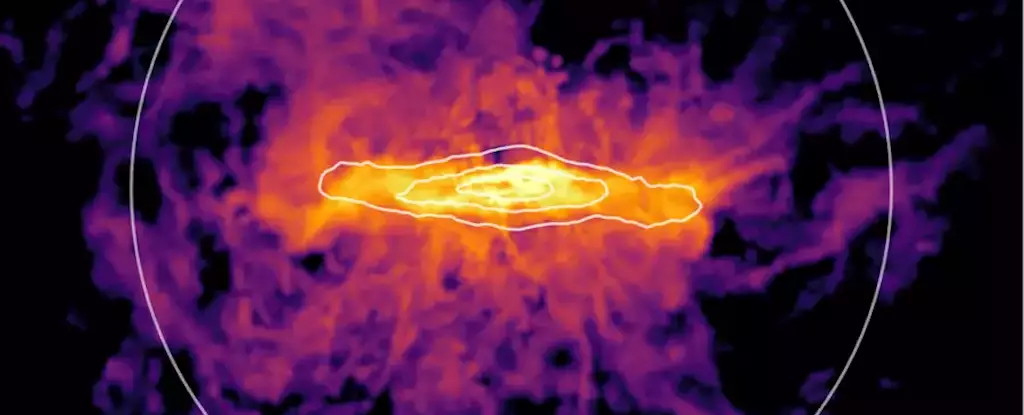In a remarkable revelation that further blurs the lines between our existence and the cosmos, recent findings from the Hubble Space Telescope illuminate the rich history of the carbon atoms that comprise our very beings. Carl Sagan famously articulated the idea that “we are made of star-stuff,” but the journey undertaken by this star-stuff is more convoluted and expansive than anyone assumed. It turns out that the carbon we embody may have traversed immense distances—hundreds of thousands of light-years—well beyond the confinements of our galaxy, only to return to our bodies after circling back through the universe.
The foundation of the elements that constitute life rests within the very lifeblood of stars. Throughout their luminous lives, stars undergo nuclear fusion, converting hydrogen into helium and further forging heavier elements. This stellar alchemy culminates in dramatic supernova explosions, which act as cosmic fountains, ejecting these elements into the vast ocean of space. The gas and dust spewed forth enrich the interstellar medium, paving the way for the birth of new stars and planetary bodies.
However, new research proposes an even more intricate narrative. The carbon generated in these stellar furnaces does not rest quietly in proximity to its birthplace. Instead, findings indicate that this vital element often undertakes a significant detour, traveling into the circumgalactic medium (CGM)—the vast expanse of gas that envelops galaxies—before ultimately being recycled back into the galactic ecosystem. This new understanding offers profound implications for the dynamics of galaxy evolution and the accessibility of carbon for star formation.
A recent study meticulously analyzed Hubble’s data regarding the CGM of eleven star-forming galaxies, unearthing startling evidence of carbon located as far as 391,000 light-years from its original galaxy. To put this into perspective, the Milky Way itself measures about 100,000 light-years across, highlighting just how vast the journey of these carbon atoms likely is. Samantha Garza, the leading researcher in this study, compares the CGM to a “giant train station,” endlessly cycling material in and out. The continuous interplay of ejections and absorptions reveals intricate pathways through which elements like carbon navigate before reintegrating into galactic bodies.
This unconventional journey, however, plays a pivotal role in the cyclical nature of star and planet formation. It is these very processes that underpin the evolution of galaxies, implicating that the stars themselves continually contribute to the nourishment and growth of their surrounding environments. Such insights reveal the paramount importance of studying CGM dynamics not merely as isolated phenomena, but as fundamental components of the larger cosmic network.
Detecting carbon in the vastness of space requires sophisticated tools to discern its spectral fingerprint, as every element interacts with light in unique ways. By employing Hubble’s Cosmic Origins Spectrograph and analyzing the light emitted from nine distant quasars, the research team was able to successfully identify the presence of carbon in the CGM. This meticulous approach helped astronomers estimate a substantial carbon mass out there—equivalent to around three million solar masses—much of which is likely fundamental to ongoing star generation.
Previously identified materials cycling within the CGM mainly included hot, ionized oxygen. This new exploration proves significant as it marks the first observation of cooler elements like carbon simmering within the circumgalactic reservoir. Interestingly, the research also delineates a definitive distinction between actively star-forming galaxies and their passive counterparts: the latter exhibit less frequent recycling of these essential compounds.
As we delve deeper into the cosmic intricacies, these observations serve to clarify how galaxies initiate and cease star formation cycles. The movements within the CGM not only shed light on the fate of colliding galaxies, such as our own Milky Way’s predicted merger with the Andromeda Galaxy, but also highlight the unseen forces that dictate the flow of elements.
In essence, our carbon—the very essence of life—has likely embarked on an extraordinary journey across vast stretches of space before settling into the fabric of our existence on Earth. This profound revelation underlines the interconnectedness of all cosmic matter, cementing Sagan’s assertion that the makeup of our bodies is indeed a continuation of celestial narratives, having roamed through the universe before finally being woven into the tapestry of life on our planet. In viewing ourselves as products of an interstellar odyssey, we gain a deeper appreciation for our place within the universe and the eternal processes that bind us to the stars.

